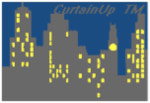ARTICLES
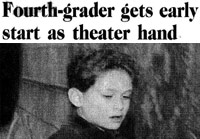 |
Fouth-grader gets early
start as theater hand.
Read more. |
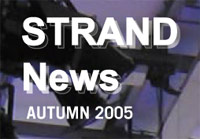 |
STRAND LIGHTING
By Bobby Harrell
THE WOMAN IN WHITE: From
West-End to Broadway
Read more about Jared employing Strand Lighting’s X-Connect on the Broadway production of THE WOMAN IN WHITE. |
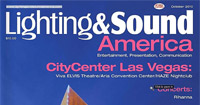 |
“GRACE UNDER PRESSURE” Lighting the USA International Ballet Compeittion, is a unique – and highly stressful – experience”
By David Barbour.
Read the article here. |
|
|
|
 |
The Who's TOMMY
VARIETY
By Bob Verini
June 22, 2008 |
|
Only one show in town can boast no risk of cell phone rage. Your Bose headphones firmly in place at "The Who's Tommy" -- piping in Steve Margoshes' pulsating La Jolla and Broadway orchestrations and Pete Townshend's lyrics with crystal clarity -- will admit no outside ringing, and any text messages will blend with Jared A. Sayeg's lighting effects.
All the while, Sayeg drenches the stage in smoke and a dazzling succession of pure white theatrical spots and saturated color rock concert specials taking the place of elaborate scenography. (Cranking up the Montalban's A/C to cope with the current heat wave could blow power to several city blocks.) |

BACKSTAGE
By Les Spindle
June 25, 2008
|
|
| Purcell's staging offers brilliant nuances. The shattering of Tommy's mirror to symbolize his breakthrough is stunningly effective. Glittering design efforts come from Brodie Alan Steele (sets), Jared A. Sayeg (lighting), and Vandy Scoates (costumes). Dan Redfeld's music direction is sublime, and Denise Leitner's choreography is wonderfully imaginative. This galvanizing production promises a fortuitous afterlife. |
STAGE SCENE LA
By Steven Stanley
June 20, 2008
|
|
| Director Brian Michael Purcell and choreographer Denise Leitner deserve major kudos for making this stage production of The Who’s Tommy so much more than it is on CD, and they are aided by the work of a superior design team: Brodie Alan Steele’s multilevel industrial rock-concert-ready set, Jared A. Sayeg’s psychedelic lighting design, and Vandy Scoate’s imaginative costumes. |
|
 |
The All Night Strut!
STAGE SCENE LA
By Steven Stanley
October 17, 2008
|
|
Jared A. Sayeg’s dazzlingly inventive lighting shines spots onto the stage though wispy clouds of “smoke,” adding to the impression that we’ve gone back in time to an era of smoky clubs and silky voices.
Gifford’s set gets a new look for virtually every song, thanks to Sayeg’s tour de force lighting. That the gifted young Sayeg can do both the subtle lighting of Trying, Educating Rita, and ICT’s recent Park Your Car In Harvard Hard—and the Vegas bedazzle of The Who’s Tommy and The All Night Strut—is nothing short of remarkable. The reds and pinks and whites of Act 1 change to rainbow colors for the second act (to complement the cast’s black and white), with the club’s walls changing from purple to blue to gold, the red lampshades atop each nightclub table providing a vivid counterpoint. |

SOCAL ARTS LIFESTYLE ENTERTAINMENT
by Audrey M. Jackson, Reviewer |
|
Jared A. Sayeg (lighting design) crafted the lighting with both
minute and large effect for the performance of each of 28 songs!
|
|
 |
Songs for a New World
LOS ANGELES TIMES
By David C. Nichols
October 22, 2009
|
|
Aided by choreographer Allison Bibicoff and smooth designs, notably Jared A. Sayeg's lighting, director Aaron keeps simplicity and emotional truth a priori, which renders his splashiest touches -- a prison-stark "King of the World," an iconic "The Flagmaker, 1775" -- doubly incisive. |
PRESS TELEGRAM
By DJohn Farrell
October 20, 2009
|
|
The Compelling Rhythm of Humanity
Aided by Jared A. Sayeg's specific and precise lighting and unobtrusive and effective sound design by Paul Fabre, they bring to life a couple of dozen characters with simple costumes found in on-stage boxes filled by costume designer Kim DeShazo. This ensemble works to allow the songs to shine without more than simple framing. |
GRUNION GAZETTE
By Shirle Gottlieb
October 21, 2009
|
|
Each composition is a complete little play. Beginning with a piece that charts the entire work’s direction, the audience follows a cross-section of characters through New World experiences on Stephen Gifford’s metaphoric set under Jared A. Sayeg’s piercing light design. |
|
 |
A Funny Thing Happened on the Way to the Forum
BACKSTAGE
By Les Spindle
March 18, 2010
|
|
Steve Orich's crackerjack music direction serves the sprightly score terrifically, and the visual elements (Bradley Kaye's set, Kate Bergh's costumes, and Jared A. Sayeg's lighting) are lush and lovely. This delicious evening of song and slapstick restores the "comedy" in musical comedy. |
STAGE SCENE LA
By Steven Stanley
March 20, 2010
|
|
Peggy Hickey scores top marks for her inventive choreography. Bradley Kaye’s scenic design has a great Disney cartoon look besides allowing peeks at the upstage orchestra. Kate Bergh’s costumes are gorgeously imaginative. Jared A. Sayeg’s splendid lighting makes set and costumes look all the more colorful. |
VARIETY
By Bob Verini
March 17, 2010
|
|
Peggy Hickey contributes witty choreography -- daddies of all ages will applaud the athletic cavalcade of courtesans in buy-me mode -- and the show looks great in Kate Bergh's mock-ancient garb and Jared Sayeg's circussy lighting. |
|
 |
Trying
LOS ANGELES TIMES
By F. Kathleen Foley
August 15, 2007
|
|
Primly clad in A. Jeffrey Schoenberg's crisp period costumes, the exceptionally talented Mozo holds her own with Mandell, and that's saying something. Watson's faultless staging is augmented by sound technical elements -- Victoria Profitt's handsome and cozy set, Cricket Myers' subtle sound and Jared A. Sayeg's virtuosic lighting design, which perfectly evokes the separate seasons of Biddle's final year. In every particular, this is an optimum production, the perfect jewel box surrounding Mandell's glittering gem of a performance -- one not to be missed. |
BACKSTAGE WEST
By Madeleine Shaner
August 15, 2007
|
|
Cameron Watson's sure direction shows a loving hand; everything good is enhanced by Victoria Profitt's superlative loft-office design, Jared Sayeg's lighting, and Cricket Myers' sound design. |
ENTERTAINMENT TODAY
By Joseph N. Feinstein
August 16, 2007
|
|
TRYING’S MAGNIFICENT SUCCESS
We all profit by Victoria Profitt's set of an office in disrepair, showing books and papers scatted everywhere and the remnants of a fire caused by the carelessness of a previous secretary that still distresses Biddle. Jared Sayeg's lighting could not be better for it reflects the many moods depicted during the action of the play. |
STAGE SCENE LA
By Steven Stanley
March 20, 2010
|
|
Cricket Myers sound design incorporates mood-setting classical music during scene changes, and Jared Sayeg’s lighting depicts the sunlight through the picture window and the passing of the seasons.
|
|
 |
Park Your Car In Harvard Yard
LOS ANGELES TIMES
By David C. Nichols
May 7, 2008
|
|
Set designer John Iacovelli provides an excellent Colonial framework filled with choice details, which Jared A. Sayeg lights with unfussy precision. |
STAGE SCENE LA
By Steven Stanley
May 2, 2008
|
|
The design elements are every bit at the level a Class A production like this one deserves. John Iacovelli’s set not only depicts Brackish’s house to perfection, but is a great fit with ICT’s thrust stage. In one particularly effect set/lighting moment, Kathleen rushes out of Brackish’s living room and into her bedroom. Lights up reveal the wall separating living room and bedroom to be a scrim, and we see Kathleen fall onto her bed and start to cry when Brackish’s bullying becomes too much for her. Kudos to lighting designer Jared A. Sayeg for this and other moments. |
|
 |
Facing East
CURTAIN UP
By: David Avery
June 14, 2009
|
|
Jared Sayeg's lighting design helps the grieving parents relive various moments from their family's past by isolating the parent who's speaking as the other parent serves as the voice of the dead Andrew. It's a poignant affect that works well in providing the audience with insight into how Andrew ended up as he did.
|
STAGE SCENE LA
By Steven Stanley
June 18, 2009
|
|
Director Dasai, working with the always brilliant lighting designer Jared A. Sayeg, stages Facing East’s frequent flashbacks seamlessly and highly effectively. Lights up on the actor recalling Andy’s childhood, lights down on the actor portraying his or her son. It sounds simple, but with Sayeg’s artistry it’s beautiful, and it works, as do all of the designer’s lighting choices.
|
|
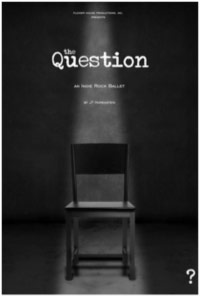 |
The Question
STAGE SCENE LA
By Steven Stanley
March 11, 2009
|
|
Contributing greatly to the beauty and power of The Question are the as always stellar designs of Jared A. Sayeg (lighting) and Stephen Gifford (set). Sayeg’s lighting provides a striking visual counterpart to the mood and tone of each dance, while Gifford makes creative use of black chairs on a black stage, with a final stairway (literally) to heaven making the performance’s climax all the more emotional. Mekhell Cassagnol’s costumes make effective use of colors, particularly red and white.
|
|
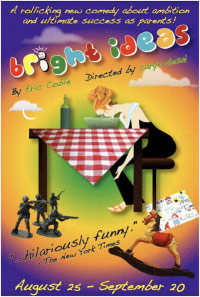 |
Bright Ideas
BACKSTAGE
By Melinda Schupmann
September 9, 2009
|
|
Jared A. Sayeg's lighting design cleverly provides scene breaks, and Stephen Gifford's simple yet effective set stylishly adds to the show.
|
GRUNION GAZETTE
By Shirle Gottlieb
September 3, 2009
|
|
Thanks to caryn desai’s (sic) insightful direction, “Bright Ideas” plays like a burlesque comedy on speed. Fast-paced and sharp as a whip, the five-member cast performs magic on Stephen Gilford’s clever, colorful set under Jared Sayeg’s sensational light design.
|
LOS ANGELES TIMES
By F. Kathleen Foley
September 2, 2009
|
|
Don’t be misled by the blue-skies backdrop or the brightly lighted checkerboard floor of Stephen Gifford’s set and Jared A. Sayeg’s lighting designs. The external cheeriness is ironic, considering the dirty work at these particular crossroads.
|
STAGE SCENE LA
By Steven Stanley
August 30, 2009
|
|
Set designer Stephen Gifford, lighting designer Jared A. Sayeg, and sound designer Bill Georges have combined forces here to make a Southland dream team. Sayeg illuminates Gifford’s green-and-white checkerboard floor into numerous configurations to signal the borders of the show’s many rooms and other locales, intersecting lines flashing hither and thither during scene changes as Georges’ slightly off-kilter nursery tunes provide just the right musical backdrop.
|
|
















